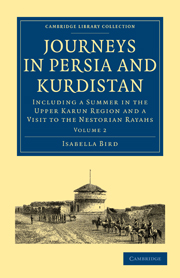 Journeys in Persia and Kurdistan
Journeys in Persia and Kurdistan Book contents
- Frontmatter
- LIST OF ILLUSTRATIONS
- LETTER XVI
- LETTER XVII
- LETTER XVIII
- LETTER XVIII (Continued)
- LETTER XIX
- LETTER XX
- LETTER XXI
- LETTER XXII
- LETTER XXIII
- LETTER XXIV
- LETTER XXV
- LETTER XXV (Continued)
- LETTER XXVI
- NOTES ON PROTESTANT MISSIONS IN URMI
- LETTER XXVII
- FAREWELL IMPRESSIONS OF PERSIA
- LETTER XXVIII
- LETTER XXIX
- LETTER XXIX (Continued)
- LETTER XXX
- LETTER XXXI
- LETTER XXXII
- LETTER XXXIII
- LETTER XXXIV
- LETTER XXXV
- APPENDIX A
- APPENDIX B
- INDEX
- Plate section
- Frontmatter
- LIST OF ILLUSTRATIONS
- LETTER XVI
- LETTER XVII
- LETTER XVIII
- LETTER XVIII (Continued)
- LETTER XIX
- LETTER XX
- LETTER XXI
- LETTER XXII
- LETTER XXIII
- LETTER XXIV
- LETTER XXV
- LETTER XXV (Continued)
- LETTER XXVI
- NOTES ON PROTESTANT MISSIONS IN URMI
- LETTER XXVII
- FAREWELL IMPRESSIONS OF PERSIA
- LETTER XXVIII
- LETTER XXIX
- LETTER XXIX (Continued)
- LETTER XXX
- LETTER XXXI
- LETTER XXXII
- LETTER XXXIII
- LETTER XXXIV
- LETTER XXXV
- APPENDIX A
- APPENDIX B
- INDEX
- Plate section
Summary
Camp Shuturun, July 25.
After that uplifted halt, which refreshed the Europeans but did not suit the health of the attendants, we descended, crossed the Zalaki valley and a low ridge, with populous camps, into the valley of the Mauri Zarin, where the nomads were busy harvesting, forded the river, and proceeded up its left bank to a dusty level on which a deep ravine opens, apparently blocked up by a castellated and nearly inaccessible rock of great height. At this place, where the Badush joins the Mauri Zarin, we were obliged to camp close to some Ilyat tents, which involved crowds, many demands, much noise, and much vigilance.
We were then in the territory of Mirab Khan, the chief of the Isawand tribe, between whom and Aslam Khan there is a blood feud, with most deadly enmity. He sent word that he was not well, and asked the Agha to go to see him, which he did, telling him that the Hakīm would also visit him. Later, taking Mirza and two guides, I forded and followed up the Ab-i-Arjanak for two miles by a most remarkable cañon. The lower part of its sides is steep and rocky, though not too steep for the growth of tamarisk scrub and much herbage, but above are prodigious conglomerate cliffs, and below, the river, which narrows to a stream, is concealed by enormous masses of conglomerate rock.
- Type
- Chapter
- Information
- Journeys in Persia and KurdistanIncluding a Summer in the Upper Karun Region and a Visit to the Nestorian Rayahs, pp. 77 - 86Publisher: Cambridge University PressPrint publication year: 2010First published in: 1891
